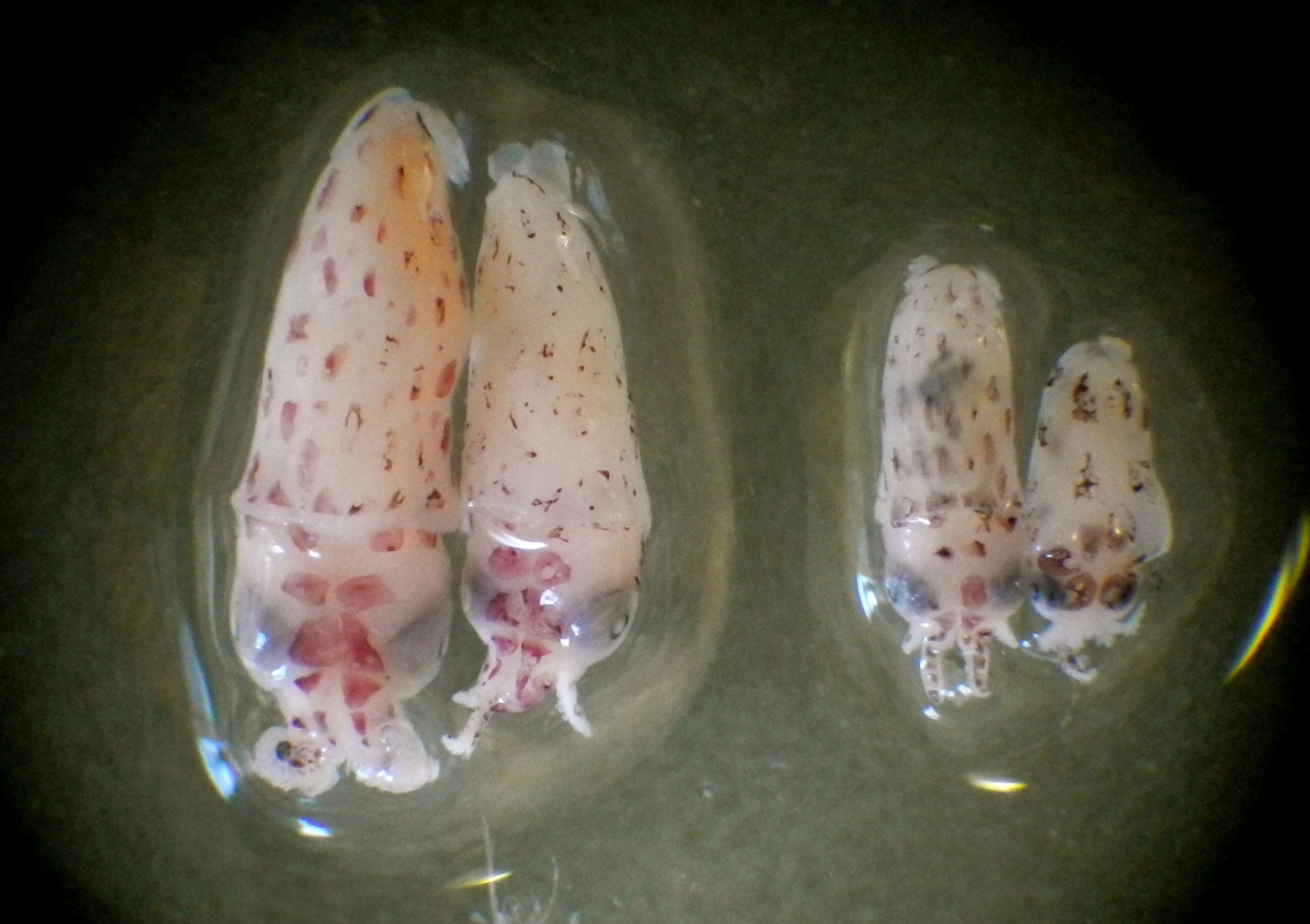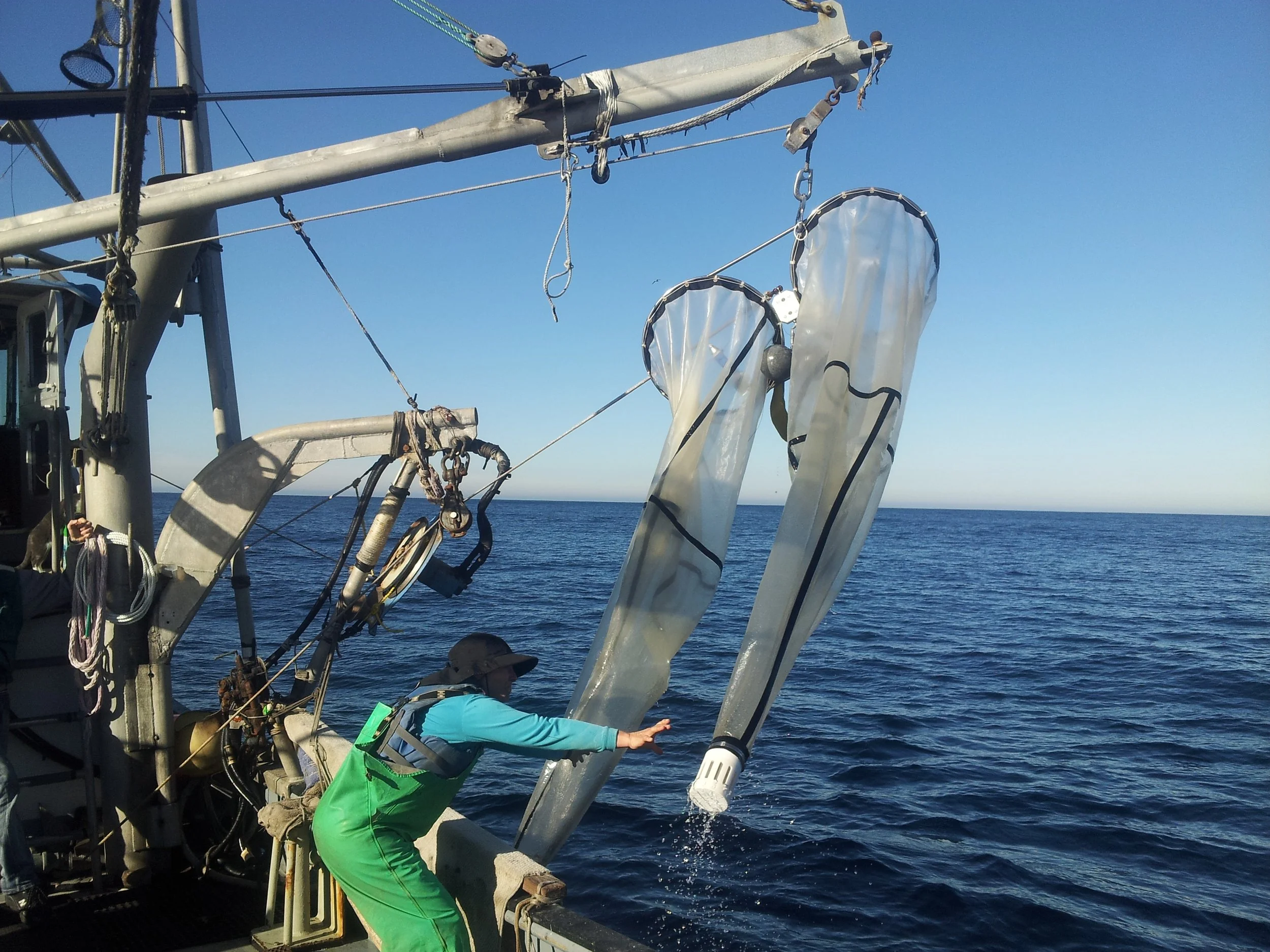RESEARCH IS THE KEY TO THE FUTURE - SQUID RESEARCH PROJECT
In partnership with the SW Fisheries Science Center and with cooperation from the Department of Fish and Game, CWPA mounted a field research program involving fishermen to expand understanding of the natural fluctuations of the market squid resource.
A five point program
A five-pronged plan emerged from the 2004 squid research workshop.
CWPA contracted with Dr. Doyle Hanan, former Senior Marine Biologist Supervisor for the Department of Fish and Game, to lead the cooperative industry-agency program. During Dr. Hanan's tenure with DFG, he supervised the squid research project as well as the CPS assessment unit, the logbook analysis unit and the marine mammal project. He also chaired the CPS management team for the Pacific Fishery Management Council and served as the Department's CalCOFI representative.
(photo : Biosonics scientist deploys hydroacoustic echosounder from fishing vessel.)
CWPA won a grant from the National Marine Fisheries Service, Southwest Fisheries Science Center, to jump-start the research, including:
• Training fishermen to tow bongo nets near spawning grounds to capture paralarvae, complementing CalCOFI offshore cruises.
• Expanding CPUE surveys with lightboats to estimate abundance.
• Collecting samples of virgin female squid to assess fecundity.
• Utilizing a Biosonics hydroacoustic echosounder to map and quantify local squid concentrations.
• Developing and maintaining a central Geographic Information System (GIS) database to house all available data, including environmental parameters such as Sea Surface. Temperature (SST), current patterns, upwelling and chlorophyll indices.
Research questions
CWPA’s market squid research program is designed to measure the variability of market squid over time, related to environmental cycles and fishing effort.
(photo : Dr. Lou Zeidberg and fishermen prepare to deploy bongo net.)
Key questions:
1. Measure regional abundance
[ weekend closure vs. fishing period • fished vs. unfished areas • inside vs. outside MPAs ]
2. Map squid occurrence/abundance relative to environmental indicators
3. Estimate fishery harvest rate vs. abundance over time
4. Examine the possibility of predicting future regional abundance by measuring Paralarvae Density Index (PDI) prior to spawning season
CWPA presented a poster at California World Ocean 2006, illustrating how this cooperative research program achieves the goals of the California Ocean Council Strategic Plan. View details of CWPA Market Squid Research poster. (3.4MB PDF)
Research updates
CWPA’s research team completed our pilot field program in fall 2007 and continue to collect data in parallel with the CalCOFI quarterly cruise schedule. We plan to post biannual reports on this website, summarizing progress and key research findings. We invite you to bookmark this website for future reference.
The CalCOFI link
CWPA’s research program focuses on nearshore waters, while CalCOFI research cruises take place primarily offshore. CalCOFI (California Cooperative Oceanic Fishery Investigations) is the acronym given to a cooperative research consortium formed in the late 1940s by the National Marine Fisheries Service (NMFS), California Department of Fish and Game (CDFG) and Scripps Institution of Oceanography (SIO) to examine the causes for the historic sardine decline. CalCOFI has become one of the premier research endeavors in North America, with one of the most important and continuous fisheries, biological and oceanographic datasets that exist worldwide.
CalCOFI cruises have been conducted quarterly for more than 50 years at permanent stations along the California coast. This research, along with CDFG dockside samples, provides the basis for much of U.S. southwest regional fisheries management today. CalCOFI research data are also used for analyses of many other components of the California Current System, providing the foundation for ecosystem management.
In 2006 the SW Fisheries Science Center coordinated the first Baja California to British Columbia synoptic field research cruise to expand knowledge of coastal pelagic species including sardine. Continued coast-wide surveys are planned in the future.
California’s wetfish industry and CWPA are proud to be a longstanding partner in cooperative research. Our goal in this partnership is to ensure the long-term health and sustainability of California wetfish resources, which we value as an integral component of the California Current System. For information on the current CalCOFI cruise, visit the Southwest Fisheries Science Center Sardine Survey webpage.
squid paralarvae at 2 to 8 days old





